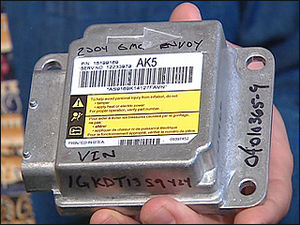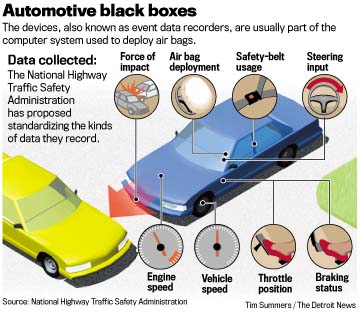T17 Group4
Project Page Topic: Black boxes in vehicles and the privacy issues associated with them.
Contents
What is a Black Box?
Event Data Recorders are small, very durable modules that come equipped in many newer cars and light trucks. The EDRs are attached to the restraint system control module of the automobile, which is the electronic device that senses impact, accelerations/decelerations and decides whether airbags and seatbelts should be deployed and tightened. The black boxes are similar to the simple, tamper-proof read-write memory devices on airplanes, but because of the rate of technological advancements in the auto industry, are much more refined and efficient. Black boxes in the auto industry can trigger airbag deployment, and also record car speed, engine speed, whether or not seatbelts were fastened, position of the gas pedal, average driving speed, whether or not the brakes were depressed and many other things. The way the black box records data is unique to nearly every automobile company; they can begin recording data only after an impact has actually taken place, begin after airbags have been deployed or even be running constantly and just continue re-writing until the event of an accident. Generally black boxes consistently record data, re writing every few seconds. Although the EDR writes over much of the information collected, it takes 250 engine starts to write over information such as a near airbag deployment, and never writes over the information before an airbag is actually deployed.
Uses
Event Data recorders were initially created by automobile manufacturers to better understand malfunctions within their vehicles through recording information on how the vehicle was operating prior to the malfunction. This is very useful as the automobile companies can gain a greater insight into exactly what was happening, which can help them solve problems quickly and efficiently.
Though EDR's are still being used for their initial purpose, they are now also being used for something else. EDR's are becoming increasingly important in reconstructing the final moments before automobile accidents. Because of all the information stored by EDR's (Speed, compression of brake and gas pedal), police are finding them to be very useful and accurate tools to help with scene reconstruction.
Event Data Recorders have also been implemented within many transport companies, used to record the hours and driving patterns of their employees. These EDR's are specifically tailored to the company’s specific needs, and can perform tasks such as sounding a warning when the truck exceeds a certain speed, and sending a report to the company if the driver does not slow down. Similar monitors can also be purchased by parents for use in their teenagers cars. These EDR’s can store up to 300 hours of data, and the information is downloadable to a personal computer. This software also allows for an alarm to sound when the driver exceeds a certain speed.
Issues
As with security cameras in public places, many people believe that giving groups the ability to access such sensitive information, even if it is for the protection of society in general, is not worth the threat it poses to an individuals privacy.
This privacy threat is caused by the lack of regulation on who has access to the data recorded by EDR’s in Canada. This means that the information recorded can be used in courts without formal laws, and can potentially be used by insurance companies when determining insurance rates, and liability.
Another issue associated with event data recorders is the fact that they were not created for the purpose in which they are being used. After our research we concluded that the positive aspects associated with the use of Event Data Recorders in cars far outweigh the negative aspects. The lead the positive aspects related to black boxes vs the negative aspects is becoming even larger as well. As the use of black boxes becomes more popular in the auto industry, government are taking more action to resolve concerns felt by the public.
Benefits
Black boxes in cars have been very successful in serving their initial purpose as a tool for auto manufactures. Through their ability to access the data recorded by EDR’s, cars are becoming safer at a much faster rate than would normally occur. Black boxes are also a great asset to our police force, even though the information was not recorded for this purpose, as it records many valuable pieces of data which are helpful in the reconstruction of automobile accidents. Because Event Data Recorders have been deemed to be admissible under the Frye standard, which means they are legally allowed as scientific evidence in court proceedings, they are as useful regarding dangerous driving convictions as DNA is regarding homicide cases.
As a part of our research we decided to visit a local police station and GM dealership to obtain educated opinions on Black boxes, and also the issue of privacy associated with them. These interviews contributed information to back up the fact that the positive aspects associated with the use of black boxes is far outweigh the perceived threat to an individual’s privacy. The individual we talked to at the police station did not know an exact value, but estimated the number of convictions made to dangerous drivers in Canada using the data recorded by EDR’S as major evidence to be in the thousands.
Even if the black boxes are not involved in the conviction of a dangerous driver, they pose other benefits as well. A man named Edward Thorndike in the 1920’s did research on a thing called “the halo effect” and this term has been linked to the use of black boxes. The halo effect is when the attributes of an object allow us to act differently than we usually would. An example of the halo effect would be how after seatbelts were put into automobiles, people felt that they were safer and began to drive more recklessly, causing the number of accidents to rise. Event Data Recorders have also been linked to this Halo Effect because if a dangerous driver is aware of the conviction capabilities of these event data recorders, then it has been found that they are less likely to commit an offence and drive dangerously.
What is Being Done to Reduce Privacy Concerns
Because of the concerns brought foreword by the public, governments have been taking action to make the public feel more comfortable through creating laws which regulate access to the information recorded by EDRs and how that information is used.
An example of one of these laws is a bill which was passed in Minnesota on March 1, 2006. The restrictions implemented by the bill stated that the information recorded by an EDR could not be accessed by anyone other than the registered owner of the vehicle unless: 1) The registered owner of the vehicle consents to the retrieval of the data
2) A court of competent jurisdiction orders the retrieval
3) The data is retrieved with the purpose of conducting research to improve motor vehicle safety, provided the identity of the registered owner is not disclosed in connection with retrieval of that data
Not only do the bills passed restrict the public from looking at the information without permission, but the insurance companies as well! There are no official laws regulating access to EDRs in Canada as of yet, but they are still being used in court cases, even without formal rules. This should not be the case for long, as the bills passed in influential countries such as Great Britain and the United States should soon have their impact on Canada as well.
Case Studies
An example of the convicting power of the black box can be seen in the case of a man in Santa Monica California, who killed 8 people after crashing into a local restaurant. The man claimed that he had passed out at the wheel due to medical reasons (a loophole which would have acquitted him of the charges). The data recorded by the Black Box in his car proved that he had been driving at an average speed well over the posted speed limit before the accident occurred and also that he had depressed the gas pedal before the impact, something that would have been impossible had he been passed out. The evidence provided by the black box alone was enough to convict the man in this case.
Another example of a black box conviction was in 2001 when a driver in Montreal crashed into another car, resulting in the death of a young man. The scene of the accident did not have any skid marks, leaving the police with no way to calculate the vehicles speed. Because of this, the suspect believed that his own testimony would be the only one, as there were no witnesses and the other driver did not live to tell the story. The driver was not aware that that their car contained a black box, which recorded their average vehicle speed at 157 km/h in a 50 km/h zone. The EDR also recorded that they floored the gas pedal 4 seconds before the impact, and that he did take his foot off the gas but did not apply the brakes prior to the accident. In this case, the information collected by the EDR was enough to convict the driver, in a case where there would otherwise be no witnesses, and no chance of conviction.
Conclusion
Event Data Recorders have been held almost directly responsible for the removal of thousands of dangerous drivers from our streets, and have been said to create a more careful drivers. The question posed at the beginning of our research asked if Event Data Recorders should be installed in automobiles even though they can compromise an individual's personal privacy. Through our research we have concluded that the benefits of black boxes far outweigh the negatives, as they are credited with convicting many dangerous drivers, creating safer cars, and may actually lead to safer drivers. This combined with the fact that governments are working to reduce the threat of personal privacy violations lead us to conclude that yes, Event Data Recorders should be installed in as many newly manufactured cars as possible.
Black Box Testing
Black box testing is a test that is used to make sure all data in the EDR system is working appropriately. The system works by determining the output against the equivalent input. It is a testing without the knowledge of how the inner subsystems that are tested work, as well the testing is used to evaluate the input and output data of the application. For example, when a black box testing is applied, the tester is only allowed to know the proper inputs but not how the outputs come up in the test. For this reason, testers and programmers must work independently.
During the testing, errors found in the process are also not avoidable. Because the purpose of black box testing is to check how the process runs, then it is just proper that the challenge of errors seeking in the system is categorized. Beyond this motive, it is necessary that the whole system is well checked before the testing. Some errors are found and categorized in the process are interface user, functions, data structures, database external access, performance, and initialization and termination of some variables.
- Advantages
• Black box testing system can be repeatedly used;
• The environment the program is running is also tested.
• Testers need no function knowledge of progression of the system;
• Testers are always the users as they should accept the system at the end, thus the testing process is done by the users views.
• Can help to find out the shortcoming and deficiencies of the system;
• Since the testers and the programmers are working independently, the result of the test is fair;
- Disadvantages
• Only specific software products are adapted to be tested;
• Due to too many of inputs in the system, only a small possible amount of input is tested;
• Programming is difficult to proceed if specifications are unclear or ambiguity;
• Inputs are hard to identify, if the programming cases are not written based on the right significant;
• There are chances of repeating tests that are already done by tester and programmer in the process;
• There are chances of having unidentified paths during the testing;
Examples of Black Box Testing
http://www.cse.fau.edu/~maria/COURSES/CEN4010-SE/C13/black4.html
Sources
http://www.cbc.ca/news/background/blackbox/
http://www.citynews.ca/news/news_1567.aspx
http://www.globeauto.com/servlet/story/RTGAM.20040506.gtwhblack06/BNStory/Technology/?query=
http://www.jlolaw.com/Articles/AutoDiagnosticModules.pdf
Prof. Dr. Hansjürgen Garstka European Academy forFreedom of Information and Data Protection
www.networkprivacy.gg/presentations/Network%20Privacy%202007_Hans%20Juergen%20Garstka.ppt
http://www.accidentreconstruction.com/newsletter/nov04/history.asp -CASE STUDIES FOR WIKIPEDIA PAGE
http://www.ncsl.org/programs/lis/privacy/blackbox08.htm
http://changingminds.org/explanations/theories/halo_effect.htm
http://www.cbc.ca/news/background/blackbox/
http://www.globeauto.com/servlet/story/RTGAM.20040506.gtwhblack06/BNStory/Technology/?query=
http://www.time.com/time/magazine/article/0,9171,1223380-2,00.html
http://www.safety-council.org/info/traffic/EDRs.html
http://www.wired.com/politics/security/news/2005/06/67952
http://www.slate.com/id/2087207/
http://www.ncsl.org/programs/lis/privacy/blackbox06.htm
http://www.harristechnical.com/cdr.htm
http://www.harristechnical.com/downloads/cdrlist.pdf
http://www.harristechnical.com/articles/mcraig2007.pdf
http://www.harristechnical.com/downloads/Askland2006.pdf
http://www.citynews.ca/news/news_1568.aspx
http://www.bankrate.com/brm/news/auto/car-guide-2004/talking-cars1.asp
http://www.njlawman.com/news/event-data-recorder.htm
http://www.usatoday.com/news/opinion/editorials/2006-01-10-letters-black-box_x.htm
http://cat.inist.fr/?aModele=afficheN&cpsidt=16152417
http://www.irmi.com/Expert/Articles/2008/Cooper08-insurance-coverage-law.aspx
http://www.lockergnome.com/cellphones/2008/06/14/does-your-car-have-a-black-box/
http://www.wesh.com/news/14573515/detail.html
http://www.slate.com/id/2087207/
http://www.tracking-vehicles.com/vehicle-event-data-recorders.php
http://www.callpie.com/articles/articles/5/1/The-Automotive-Event-Data-Recorder-EDR/Page1.html
http://www.sfgate.com/cgi-bin/article.cgi?f=/c/a/2002/09/02/BU167062.DTL
http://www.ingentaconnect.com/content/pep/jae/2004/00000218/00000009/art00006?crawler=true
http://ezinearticles.com/?Discovering-Black-Box-Testing-Advantages&id=1275749
http://www.cse.fau.edu/~maria/COURSES/CEN4010-SE/C13/black4.html
http://creativetesters678.blogspot.com/2008/07/advantages-and-disadvantages-of-black.html



